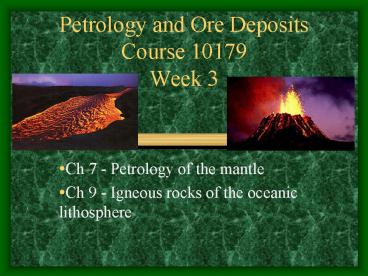Petrology and Ore Deposits Course 10179 Week 3 - PowerPoint PPT Presentation
1 / 26
Title:
Petrology and Ore Deposits Course 10179 Week 3
Description:
Basalts originate from the mantle but our knowledge of the interior of the Earth ... Is there any petrologic or tectonic reason why they should or should not be? ... – PowerPoint PPT presentation
Number of Views:262
Avg rating:3.0/5.0
Title: Petrology and Ore Deposits Course 10179 Week 3
1
Petrology and Ore DepositsCourse 10179Week 3
- Ch 7 - Petrology of the mantle
- Ch 9 - Igneous rocks of the oceanic lithosphere
2
Ch 7 - Petrology of the Mantle
- Basalts originate from the mantle but our
knowledge of the interior of the Earth is very
limited because of physical inaccessibility
3
Gross Vertical Structure of the Interior
- Crust
- Upper mantle
- Transition zone
- Lower mantle
- Outer core
- Inner core
4
Gross Vertical Structure of the Interior
- Lithosphere
- Asthenosphere
5
Physical Characteristics of the Mantle
- Horizontal Density Heterogeneity
- Seismic tomography
- http//www.seismo.unr.edu/ftp/pub/louie/class/100/
interior.html - http//www.uiggm.nsc.ru/homepages/geophysics/ris/
6
Physical Characteristics of the Mantle
- Temperature Distribution
7
Mantle Convection
Fig 7-4
8
Chemistry and Mineralogy of the Mantle and Core
- Meteorites
- Xenoliths and xenocrysts
- Experimental petrology
9
Estimates of Mantle Chemistry
10
Mantle Petrology
Melting
Solidus
11
Melt Formation
12
Ch 7 - Study Exercises
- 1. Our knowledge of the composition and structure
of the mantle is based on both direct and
indirect (remotely sensed) observation, combined
with modeling and experimental simulation. How
deep in the upper mantle does our direct
observational database extend? What does this
database consist of? - 2. The perovskite crystal structure is of great
interest to geophysicists. Why is this crystal
structure so relevant to magnesium silicate phase
transitions in the upper mantle? - 3. "Seismic tomography" of the mantle shows
significant lateral variations in seismic
velocity that have been linked to lateral
compositional or thermal variations. What
influence would these variations have on
generation and ascent of basaltic magmas? - 4. Why do xenolith-bearing basalts typically show
much less diversity of xenolith rock types than
kimberlites show? - 5. Discuss petrologic explanations for the
physical properties and mechanical behavior of
the asthenosphere (1ow-velocity zone).
13
Ch 8 Igneous Rocks of the Oceanic Lithosphere
14
The Nature of Mid-ocean Ridges
15
The Nature of Mid-ocean Ridges
16
MOR Magma Heterogeneities
17
Ophiolite Stratigraphy
The Ophiolite Model
18
Geochemistry of MORBs
19
Fractionation Trends of MORBs
20
Petrogenesis of Seafloor Basalts
21
(No Transcript)
22
(No Transcript)
23
Ocean Island Basalts (OIBs)
24
Chemical and Mineralogical Characteristics of
Ocean Island Rocks
25
Petrogenesis of Ocean Island Magmas
26
Ch 8 - Study Exercises
- 1. Is the discovery of "smokers - that is, vents
for mineral-rich hydrothermal waters on mid-ocean
ridges consistent with the incipient alteration
of seafloor basalts that is commonly observed in
dredge samples? If so, how? - 2. Summarize the chemical distinctions between
NMORB and E-MORB, and relate these to the
genesis of each type of magma. - 3. How does the petrogenesis of MORB magmas
differ from that of OIB magmas? Do their
differing chemistries relate more to different
depths of origin in the mantle or to fundamental
chemical contrasts in their mantle source areas? - 4. Are hot spots limited to oceanic lithosphere?
Is there any petrologic or tectonic reason why
they should or should not be? - 5. OIB magmas are considerably more diverse
chemically than MORB magmas. Is the great
compositional range of OIB magmas related more
closely to (a) chemical evolution of a common,
mantle-derived parental magma for the suite, or
(1)) complex melting of compositionally
heterogeneous mantle over a range of depths?































